ALLIGATOR
BEHAVIOR page 3b: CONFLICT AND CANNIBALISM page 2 Page 1 3 4
This
page was born 06/14/2013. Rickubis designed it. (such as
it
is.) Last update: 02/03/2022
Images
and contents on this page copyright ©2001-2022 Richard M.
Dashnau
Alligators
usually follow a series of non-violent behaviors when interacting
with each other.
But they are animals, not machines, just like we are. People, which
are
supposed to be "civilized", may react savagely
if provoked in the right
way. The same can be said for any of our domestic animals.
Occasionally,
even alligators will react violently towards each other. It is
foolish
to provoke any wild animal, regardless of size
or disposition. The
animals
have a right to live in their habitat, and humans can share it with
them if they take the time to understand the animals.
May
13, 2012-- I
was on my bicycle on the Spillway Trail, heading towards Elm Lake. I
was about 20 yards from the West end of the Spillway Bridge when I
heard a loud splash. Since a loud splash
at Brazos Bend
State park frequently means an alligator has caught something, I
turned
around to look for the cause of the disturbance. I found the source of
the splash. There were two alligators,
about 7 feet long, biting
onto each other. They had each grabbed the other near the
hindquarters--near the base of the tail. When an alligator expends the
effort
to attempt to crush something, shake
something, or twist something in
its jaws, it usually has to rest for a while afterwards. This rest
period can be from 5 minutes to a half-hour long. I saw this
behavior during the hour or so that I watched
these two. I shot some
photos--but mostly video--during that time. The images below are from
the video
clip (mp4) that I shot today.
-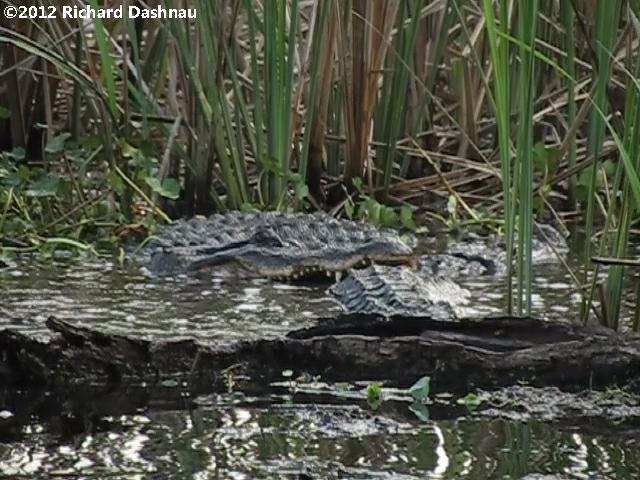 --
--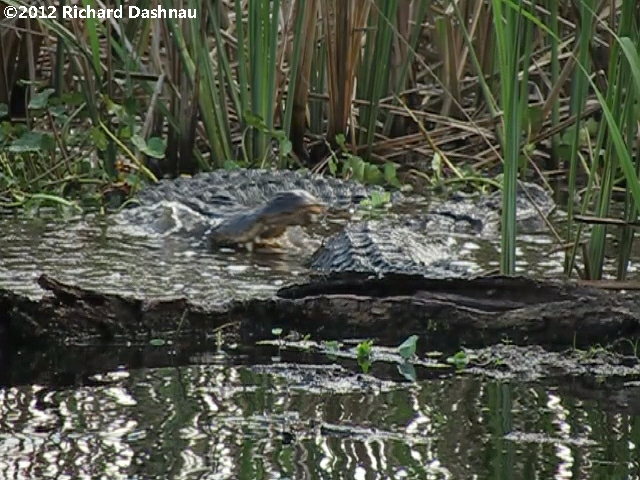 --
--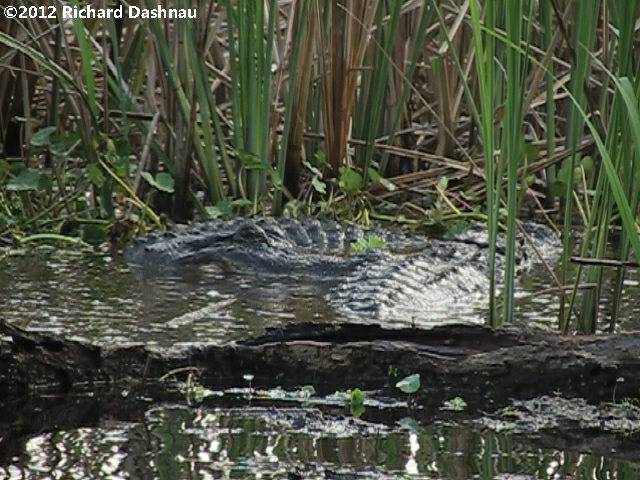 --
--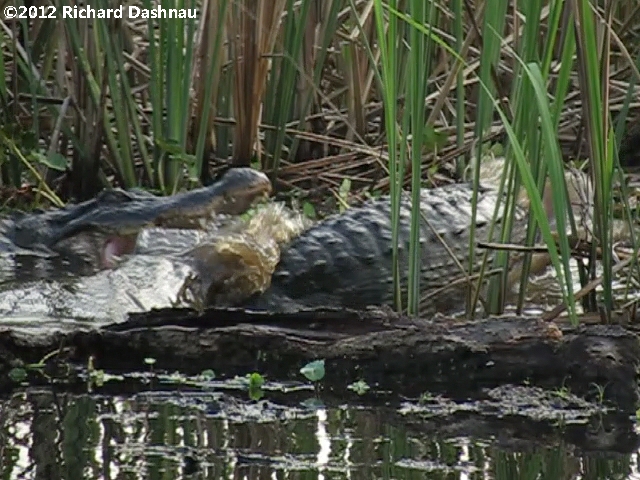
It
was
still mating season, so it was not unusual to see two alligators in
this kind of disagreement. At first, I thought that this was an
odd situation, since the alligators attack and defend
with their jaws.
But on further thought, it does make sense. Many
alligator interactions are very subtle, and postures of dominance and
submission are usually performed with a minimum of
movement and speed. The
submissive alligator will usually turn and swim
away, and is occasionally followed by the dominant one.
And...sometimes
the dominant alligator will increase speed, and chase
rapidly--and will sometimes
clamp jaws on the retreating alligator.
The "clamp" usually brief (especially if the two are similar in
size).
But, what would happen if the chasing
alligator grabbed the retreating alligator by the base of the
tail, and
the retreating alligator curved itself back and bit the chasing one?
It
couldn't bend its body too sharply, and so would
probably clamp its jaws on the other alligators' hindquarters (where
it could
reach). The
result would probably look very much like the situation I found.
--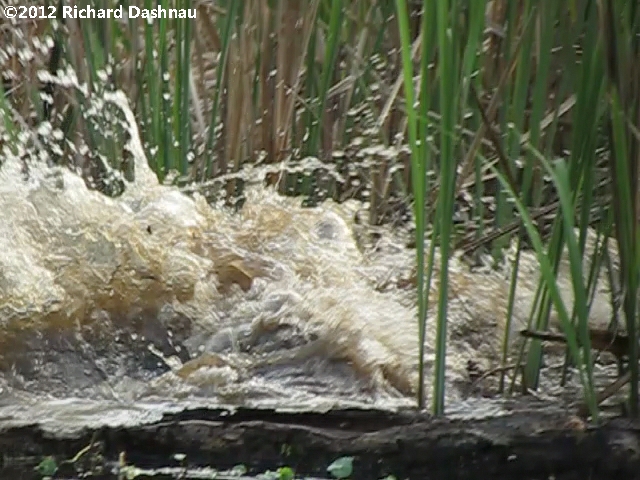 --
--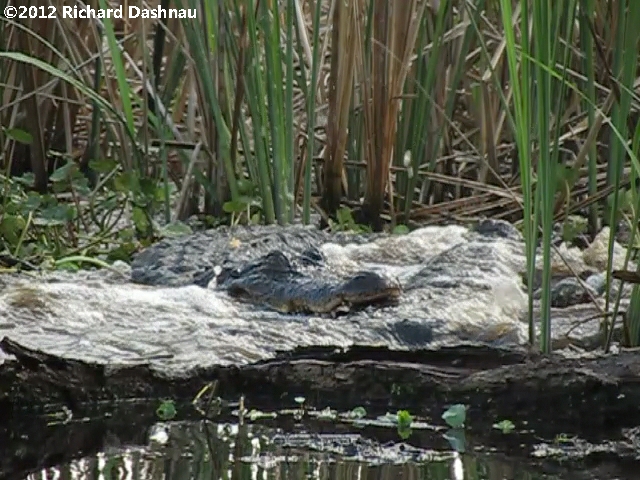 --
--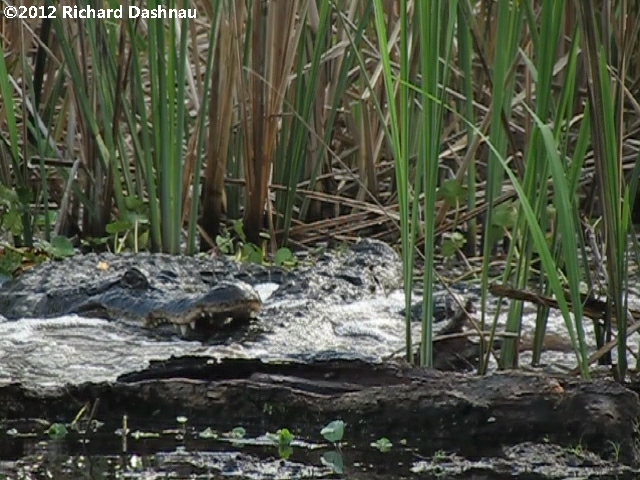 --
--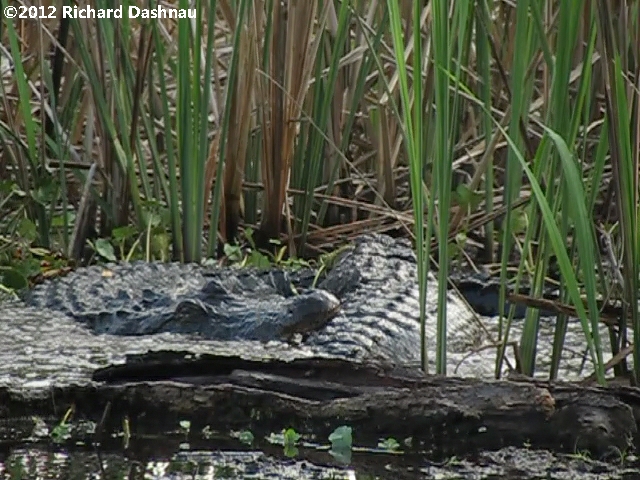
The
alligator
on the right seemed to have the better grip. The right
alligator would occasionally try to shake the left alligator. It might
have been trying to roll as well. But when the water
turbulence
subsided, I could see that the left alligator had
clamped its jaws around the body of the right alligator. That
would prevent the right alligator from slinging the
left alligator around.
--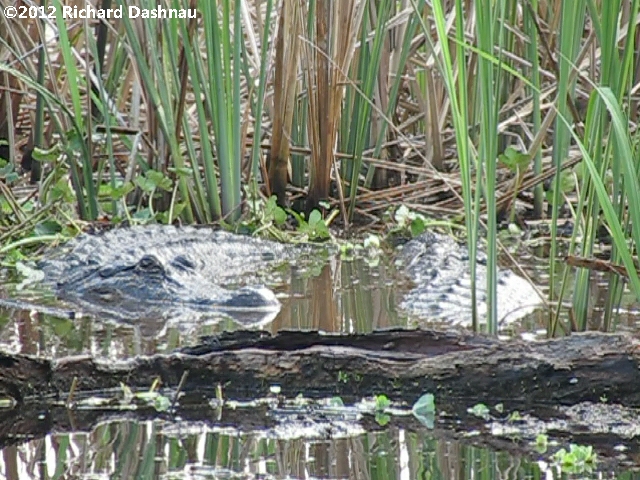 --
--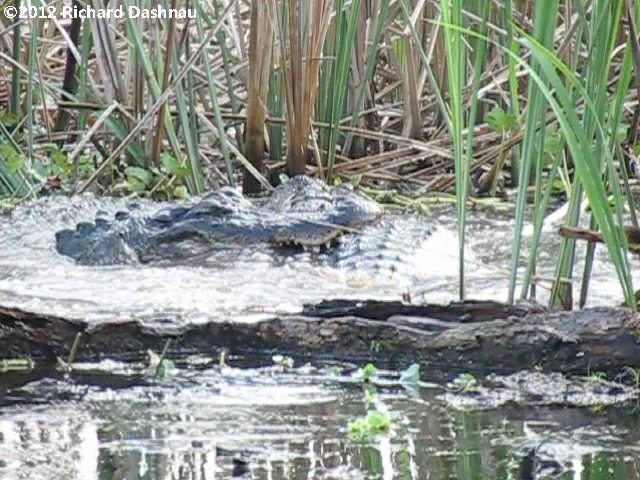 --
--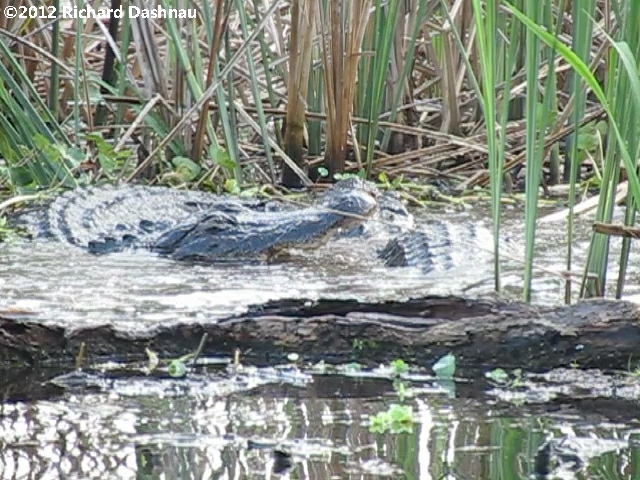 --
--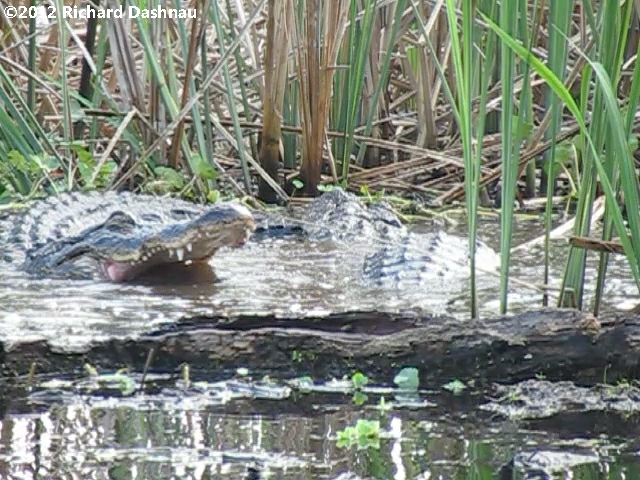
The
alligator on the left would sometimes open its jaws and let go.
But the right alligator did not respond by opening its jaws. So
the left alligator tried to clamp onto the right alligator again.
--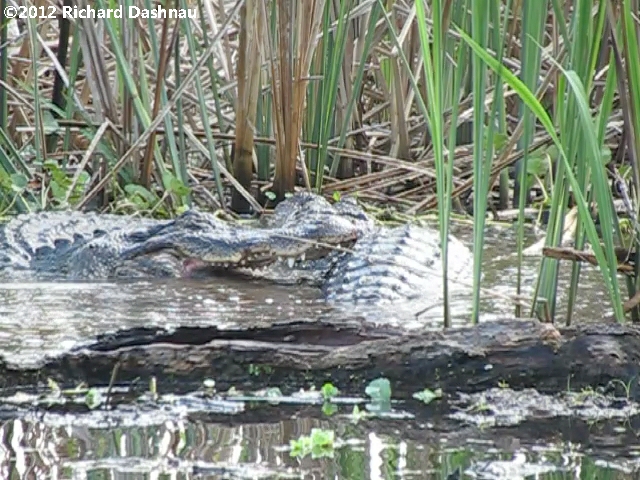 --
--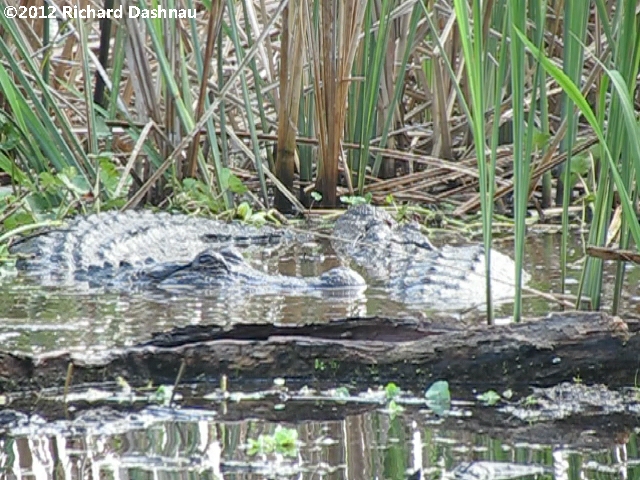 --
--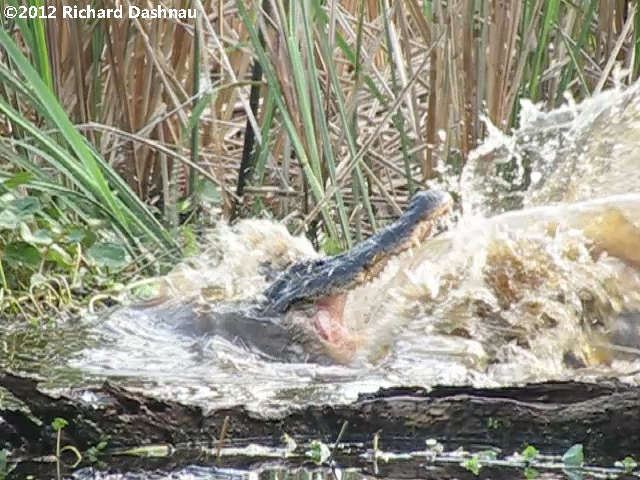 --
--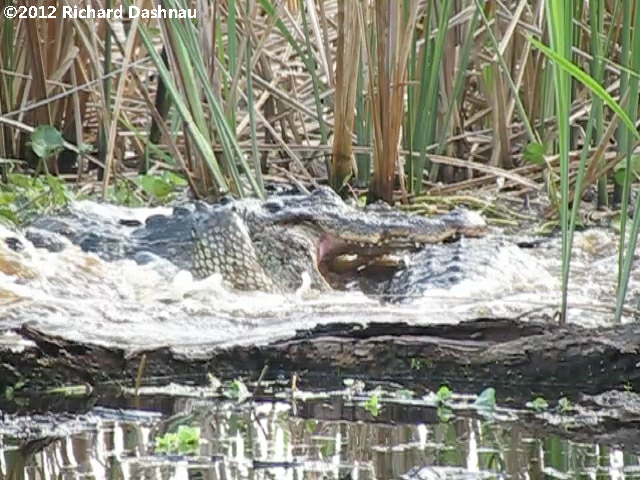
It would try to get its jaws around the right alligator's body.
While it tried to do this, I could see (and hear) the teeth of
the left alligator scraping on the back (and osteoderms) of the
right alligator.
BOTH alligators would try to crush
whatever part of the other alligator was between their jaws. I could
tell by the heads jerked while the jaws clamped and the huge jaw
muscles expanded with the effort,
--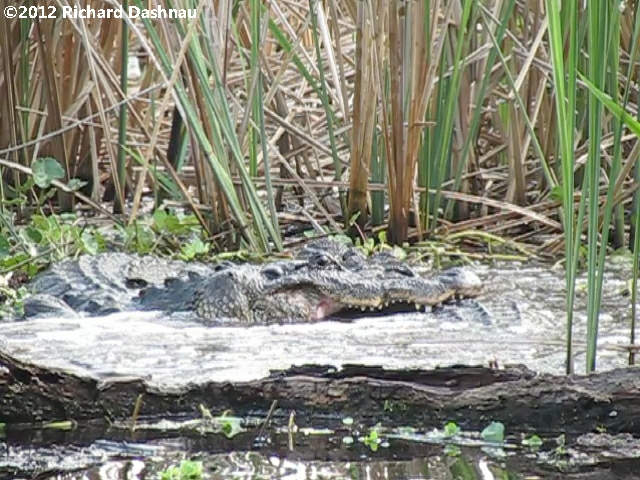 --
--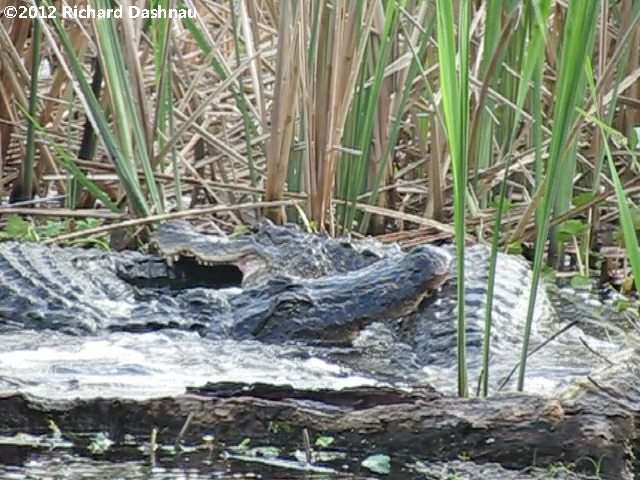 --
--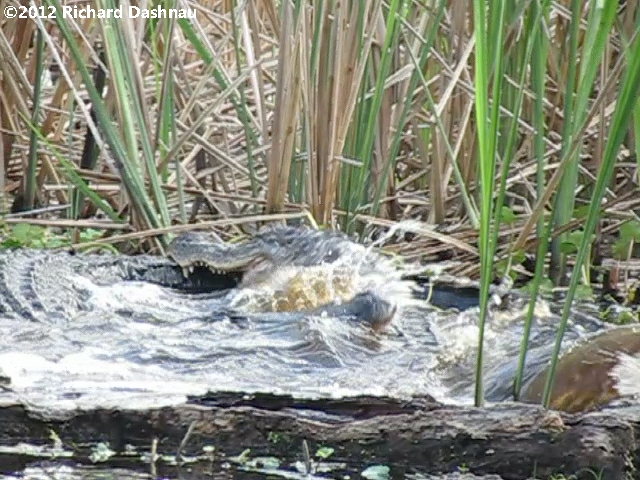 --
--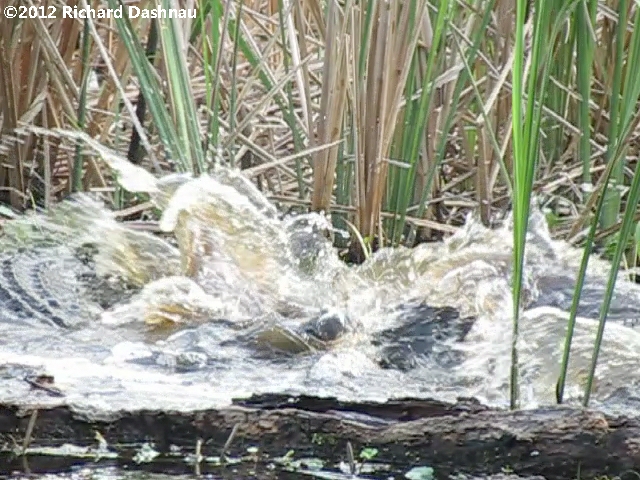
When the right alligator would begin its shaking movement, I
noticed that it would turn the top of its body counter-clockwise
(towards the left). Of course I can't tell if this was
a preferred movement,
but it seems to me that the alligator could
have turned either way. What's interesting about turning to the left
is--in this situation--it would turn the osteoderm-covered back of the
alligator (and not the
softer underside) towards
the teeth and jaws of the other alligator. This would would use those
surfaces to the best advantage for protection.
--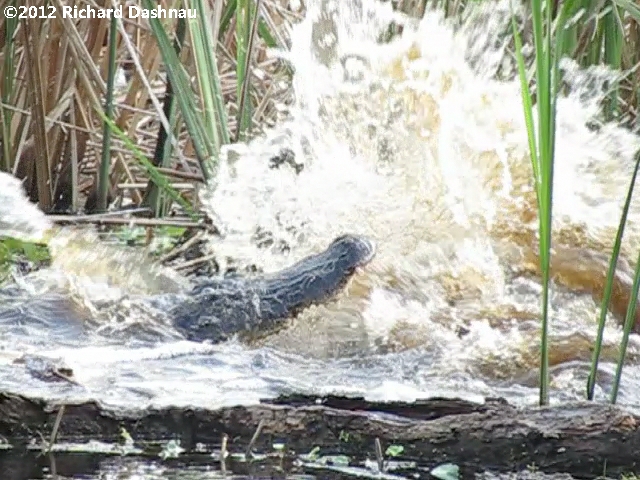 --
--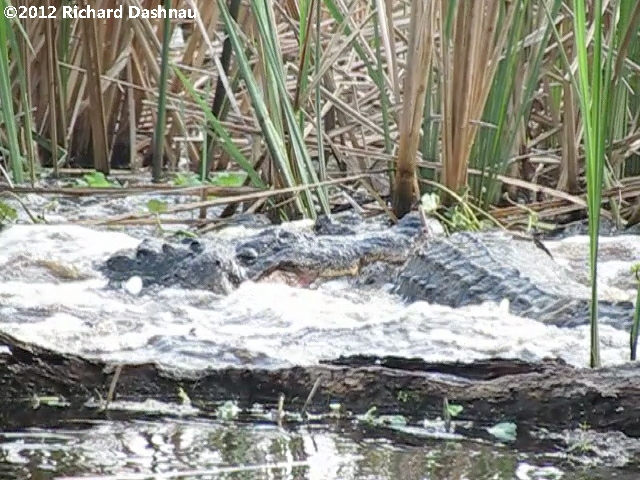 --
--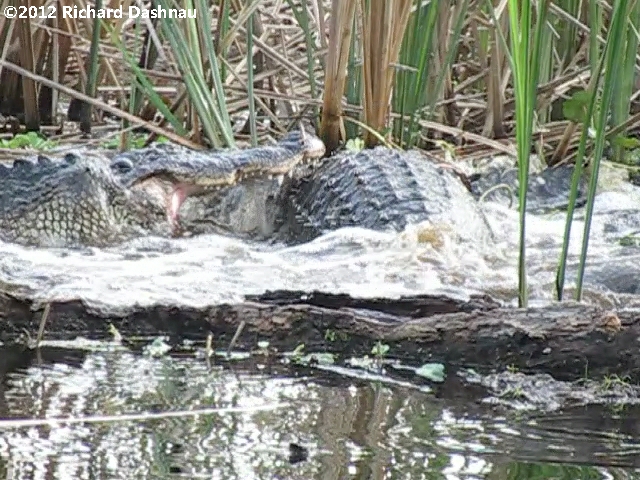
I've
a
read a number of items about the cost in energy and food for growing
those disks of bone (the osteoderms) on the alligator's back. For
alligators to have expended those
resources for millions of years, osteoderms must be useful for
something. I've read that they serve as support
structures to reinforce the spine, and also as an aid in
thermoregulation.
They are often referred to as
"armor". References to these and other purposes of osteoderms
can
be found in: "Internal vascularity of the dermal plates of Stegosaurus
(Ornithischia, Thyreophora)" by James O. Farlow, Shoji
Hayashi, Glenn J. Tattersall; specifically pages 8-9 (the section
called "Function of alligator osteoderms"). Other studies can be
found in the
"references" section of that paper. It can be found
online here: http://www.brocku.ca/researchers/glenn_tattersall/PDFs/farlow
et al stegosaurus.pdf
In my videos here, it seems that they are
acting as a sort of armor. Since the osteoderms can be used to
redistribute various mechanical stresses on the skeletal
structure,
perhaps they
could also be a mechanism for redistribution or absorption of the
compressive stress from another alligator's jaws. At least,
that's how it seems to me.
But, that's
just a guess on my part.
I watched these alligators for about an hour, but I had to
leave
to conduct a scheduled hike. By the time I was able to return to
the area, I couldn't find any wounded alligators that I could be
sure were
one of these two. Once again, here's a link to
the video
clip (mp4).
April
28, 2011- June 11, 2011:
A 7-foot-long alligator was reported (Thursday 4/28) with a
horrendous wound in its side. A bite from a larger alligator seemed to
be the cause. When I went out to the park
the following Sunday (5/1) I
found the alligator. When I first encountered it, it was moving
leisurely in the water, showing no sign of discomfort--except for
large
amounts of water being expelled periodically
from its side. It later
came ashore, and I got a better look. The images below show this
wound, and what appears to be the surface of a lung, inflating and
deflating. Although this is a huge wound, we would
NOT make an effort
to repair the alligator. Generally, it is park policy to remain
uninvolved in the natural events at the park.
---------------------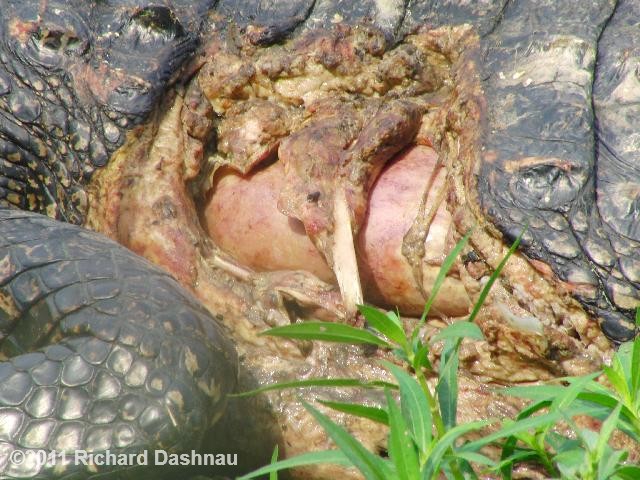 ----
----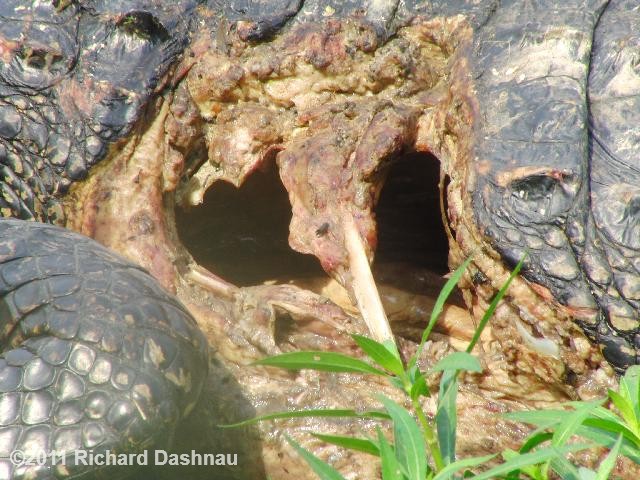 ---
---
----
EXHALATION
INHALATION
I have also uploaded two edited video
clips to my web host. Here they are: Wounded
alligator 1 Wounded
Alligator 2
I
observed the alligator over 5 or 6 weeks, and it remained in the
same area of the lake. During most of that time, the wound was covered
by a mat of algae and various plants. When I did get a good view
of the
wound, it seemed to be about the same. We didn't expect that the
alligator would die from infection. Studies have proven the antibiotic
properties of alligator blood. Basically, alligator blood is
an
antibiotic all by itself--having demonstrated an ability to
kill many kinds of fungus, bacteria, and virus pathogens. Ongoing
studies continue to see if this antibiotic property can be used to
benefit humans.
During the weeks I watched the alligator, many
people (park visitors, and I) wondered what we were actually seeing
inside the wound. What was that "membrane"? I wrote to a few
people who would know
about this, and got a reply from Dr.Leon
Claessens. I was also able to look at his article, "A Cineradiographic
Study of Lung Ventilation in Alligator mississippiensis", (Claessens
LPAM. 2009. A
cineradiographic study of lung ventilation in Alligator
mississippiensis. J. Exp. Zool. 311A:563–585.). The article is
very detailed, and quite technical. However, Dr. Claessens'
explanation
helped clarify it
for me. This is what I understand was going on, and
the pictures will help me explain.-
-Alligators
have thin bones called "gastralia" within their abdominal muscles.
(figure 2). These act with the muscles to allow the abdomen to be
expanded and compressed with extra force. Other structures
that assist
in respiration are muscles (diaphragmaticus) that attach to the liver.
These pull the liver back, which expands the lung cavity. The
spine can flex up and down to a certain extent; and this also helps
expand the lung cavity. During inhalation, all of these work together
(Figure 4) to increase the volume of the lung cavity. The lungs and
heart are also enclosed in a large "sack". In normal conditions,
when
this volume is increased, air rushes into the lungs to fill the
void. But this
alligator had that huge breach which prevented that expansion from
pulling air into the lungs.
-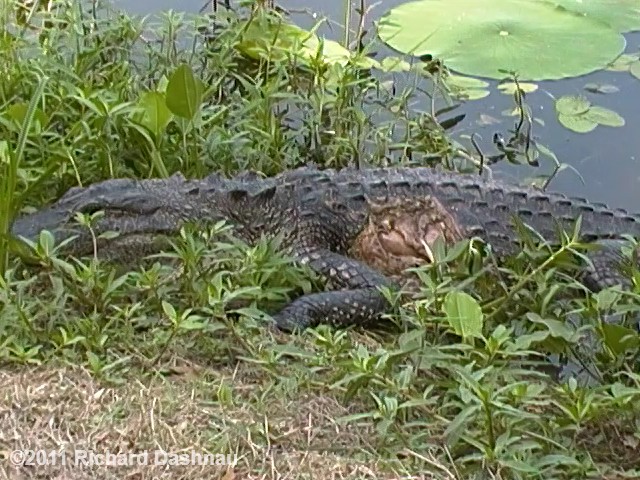 -
-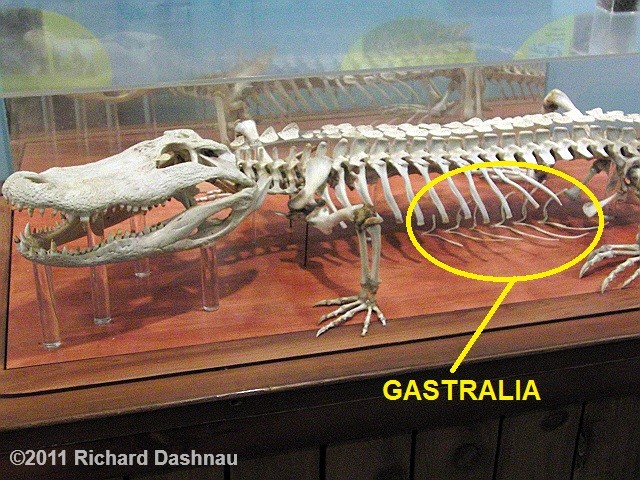 -
-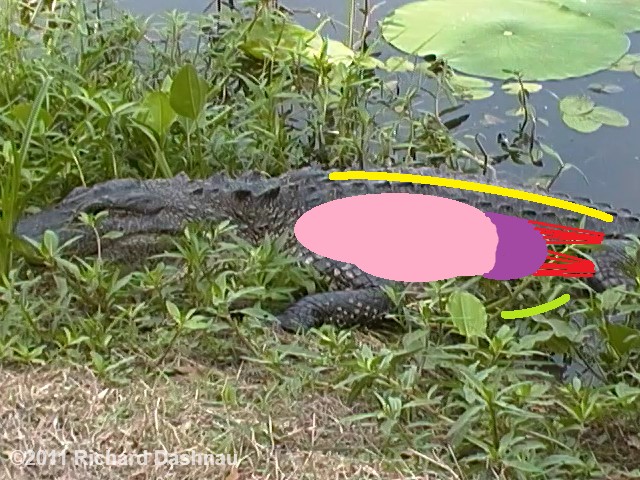 -
-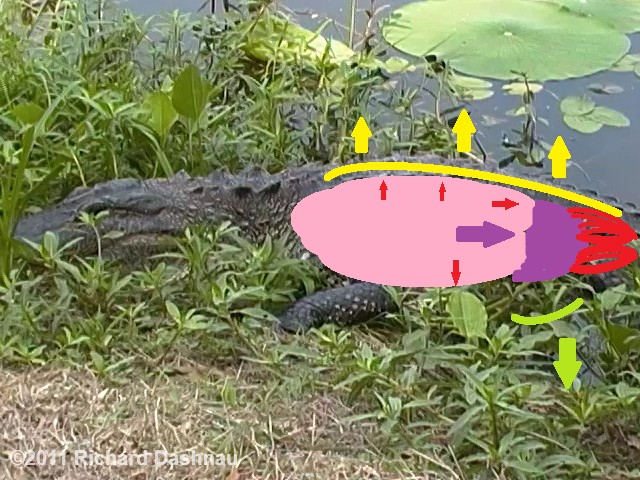
FIGURE 1
FIGURE 2
FIGURE 3
FIGURE 4
In normal conditions, when this
volume is increased, air rushes into the lungs to fill the void.
(figure 5) But this
alligator had that huge breach which prevented that expansion from
pulling air into the lungs
(figure 6). So, instead of that nice
expansion filling the lungs, the liver is pulled back, and then the
collapsed lung and other organs are pulled back. (figure 7) But, this
is just the physical movement of soft
materials. Then, when
things relax, and the lung cavity contracts--that same mass of soft
materials is just squeezed forward again. Since that connective sack
holds everything together, the soft materials
"fill it back up" and it
is pressed against the inside of the hole. (figure 1) One lung
was probably collecting some air, but there was no chance the the
alligator was getting its full amount of air. I've simplified
this quite a bit. Alligator respiration is a complex process using
integration of many structures and processes.
The
alligator was finally reported dead on 6/11/2011. When I went to the
park the next day, I couldn't find the carcass. It appears that
something (probably an alligator) had dragged it off. For
further
information, you can see Dr. Claessens' work here: Claessens
Laboratory. Also...a big thank you to Dr. Claessans for
taking the time to answer my email, and for his generosity.
-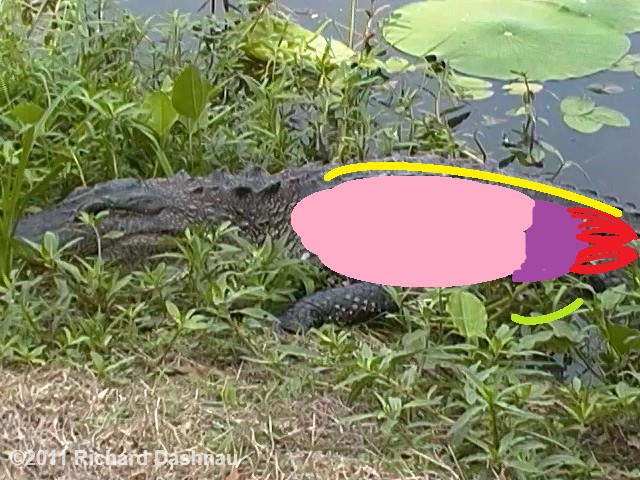 -
-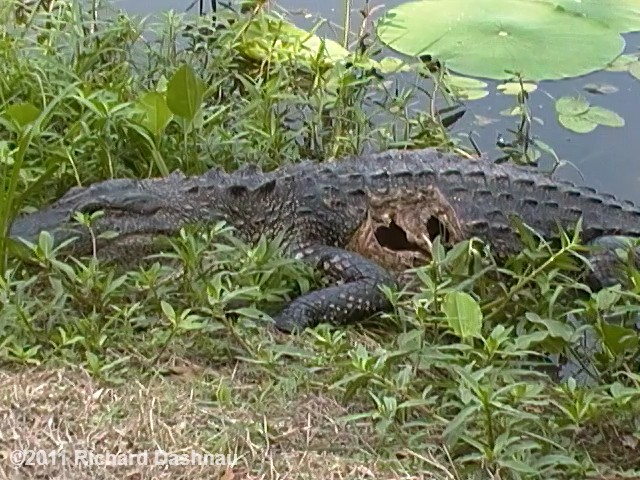 -
-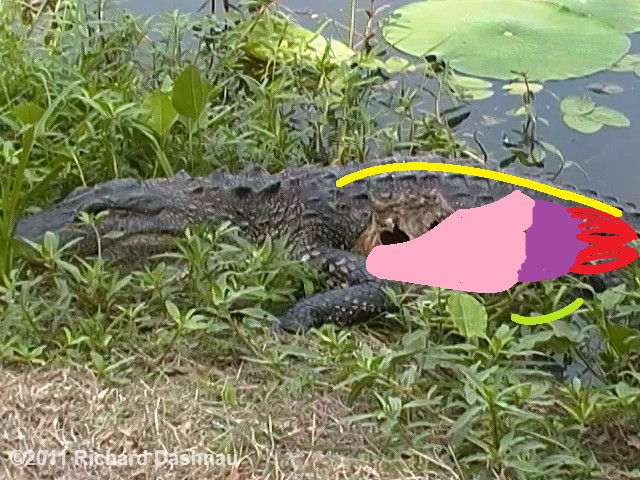
FIGURE 5
FIGURE 6
FIGURE 7
April
24, 2005
This is nearly the final act of a drama that seems to have started
sometime
Wednesday, 4/20/2005.
A
six-foot
long alligator was seen in the jaws of a much larger alligator
Wednesday.
Rich witnessed the dead alligator being carried from 40-Acre Lake
to
Pilant
Slough by passing under the Observation
Tower bridge sometime Wednesday
afternoon. This same alligator stayed near the Observation Tower
in
Pilant
Slough for the rest of the week. During this time it continued
chewing
on the deceased
alligator. If I understand correctly, David feels that
the large alligator abandoned the carcass a day or so before
Sunday.
After
being abandoned by the large alligator, the carcass was claimed by
another
alligator, estimated at about 10-feet long. It then stationed
itself in
the same area occupied by the previous larger alligator. The
second
alligator
is the alligator pictured here.
--------------------------------------------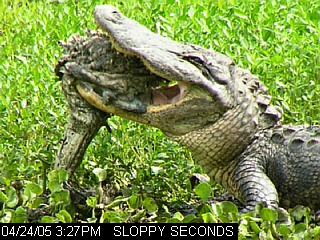
CHOMP!
I was
lucky enough to briefly see some of this Sunday afternoon
4/24/2005. (I
saw it very briefly Thursday morning, but couldn't stay to watch,
then.)
As more visitors passed by the observation tower
Sunday afternoon, they
got to see the occasional carcass-thrashing as the alligator tried
to
fragment
the remains. The image above (CHOMP) is a picture taken during one
of
the
chewing intervals.
The caption refers to the fact that, well, the
alligator
is
eating seconds, and they are obviously "sloppy" (see TASTES LIKE
CHICKEN,
and CLOSER, below).
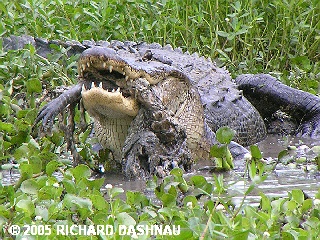 -
-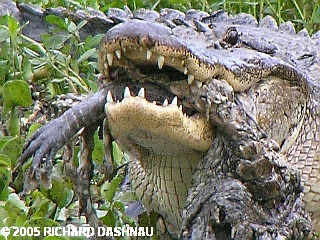 -
-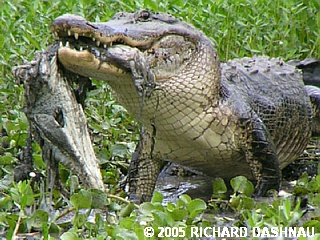
TASTES
LIKE
CHICKEN
CLOSER
VIEW
READY
TO
WHIP
-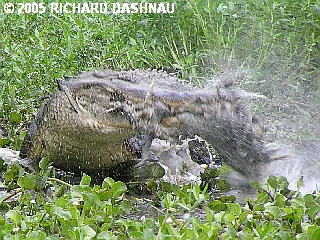 -
-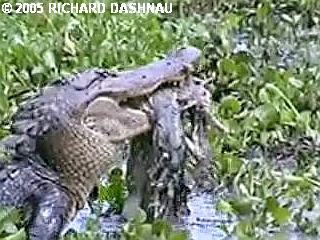
WISH I HAD A KNIFE!
PREY
WHIPPING VIDEO(543kb)
Through
the day, a pattern became obvious as the alligator would lie
still
for a long time (15-30 minutes) and then thrash (or whip) the
carcass
for
just a few moments; and then rest for another long interval.
The
image above (READY TO WHIP) shows the alligator preparing to whip
the
carcass
by lifting its head, front part, and the carcass off the ground.
You
can
see that the head is still attached to the carcass
is and hanging below
the live alligator's jaw. The next image (WISH I HAD A
KNIFE,
above)
shows the end of the whip arc as the alligator has swung its head
from
our left to our right. These are 2nd and
3rd in a series of 5 images I
shot in a burst. I discuss more of the mechanics of the
prey-thrashing
on one of my other pages, here.
I've also got a short
clip(543kb),
taken before the other pictures, of this
prey-whipping motion.
Or,
see the image of a single frame from the clip above (PREY WHIPPING
VIDEO).
I had
a lot of fun talking to the visitors about alligators in general
for a
few hours that Sunday. While there were about 20-30 people
near
the
Observation Tower, I was looking through my camera when I heard
a
number
of voices raised in suprise. When I turned towards the
voices, I
saw that an alligator (about 8 feet long) was crossing from
40-Acre
Lake
to Pilant Slough by walking over the trail--maybe about 12
feet in
front
of the water station. It was taking advantage
of a
large gap among the visitors. After I shouted to "give it space",
and
"just
let it pass", everyone moved back a bit, and the alligator made
its
slow
way
across the trail and down into the Slough. The crowd was entranced
by the event, which took a few minutes.
It was
EXCELLENT! Unfortunately, I had the camera turned towards
the
other
side of the Slough,
with a tele-adapter on it, so I couldn't get a shot
of this alligator calmly walking past (through) the large group of
people.
I confess that I was concentrating on the crossing alligator and
making
sure everyone was
a safe distance from it through most of this incident,
so I
didn't really think much about looking away long enough to
readjust
anything,
anyway. It was also a good opportunity for more interpretive
material
on
alligators and of course I used it. Sharon was also nearby during
this
as well, and I
believe
she also got to see the whole thing.
Why,
or how the smaller alligator came to be deceased is unknown to me
at
this
time. Many of us suspect that this was the outcome of a
territorial
conflict,
but no one saw the kill. Alligators become mature at
about 6 feet long
(6 years of age). The dead alligator is estimated to be about 6
feet
long.
Alligators
are territorial. The larger alligators will have the largest,
"best"
territories,
and there are potentially alligators
of all sizes and ages withing a
single
territory. On any year, in a healthy population of
alligators, it
stands to reason that there could be at least one
newly-mature
alligator
in any one territory. This alligator will
seek to mate, and claim an
area.
It will announce these intentions by bellowing, headslapping, and
so
on.
Unfortunately for the new adult, these signals may not only
attract a
potential
mate--they can also attract
at larger alligator that has already
claimed
the vicinity. I've seen this type of situation myself.
One
one of these occasions, I watched as two smaller males (about 7
feet
long)
bellowed about 20 feet apart. I thought that they might challenge
each
other. But, before this could happen, a much larger male
(at least 10
feet
long) came cruising from around one of the islands and went
straight
towards
the two smaller males. They both turned and swam away from
the
approaching
large male.
If
either
one of the smaller
males decided to challenge, it could have been
interesting,
but it could have resulted with the smaller one's death. It can be
seen
by these behaviors that an alligator population can control
itself.
Hunting
or culling
by outside influnce is unnecessary--providing that the large
alligators are left alone. Killing the largest alligators (As some
people
want to do for "trophies"--what a ludicrous concept. Why not shoot
a
log
and hang
that on a wall? No challenge or sport in killing an
alligator.)
only leaves large territories open for smaller alligators to
split, and
allows more smaller alligators to inhabit an area.
This
has been one of my better days, that's for sure.
And,
this
page shows alligators at the park, on land, near various landmarks
at the park.
Go back to my main alligator
page, Alligators
Go
back to my home page, Welcome
to rickubis.com
Go
back
to the See
the World page.
 --
-- --
-- --
--
 --
-- --
-- --
--
 --
-- --
-- --
--
 --
-- --
-- --
--
 --
-- --
-- --
--
 --
-- --
--














